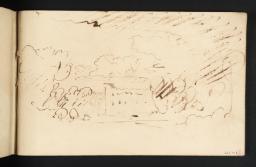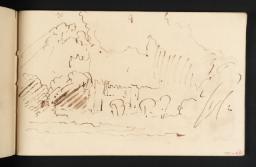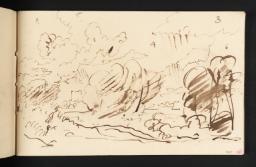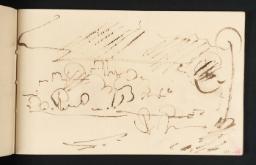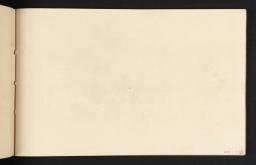J.M.W. Turner
>
1802-18 Academician and professor
>
Thames sketchbooks c.1804-14
>
Composition Studies Sketchbook
Turner Bequest LXV 1–30
Sketchbook bound in marbled paper covers
30 leaves and endpapers of cream laid writing paper; page size 118 x 184 mm; watermark ‘J Lar[king]’ with crowned fleur-de-lys emblem lettered ‘L’ and dated ‘[1]801’ (trimmed)
Made by John Larking, of Upper Paper Mill, East Malling, Kent
Inscribed by Turner in ink ‘117’ on white wove paper label, 20 x 55mm, pasted around spine
Numbered 366 as part of the Turner Schedule in 1854 and endorsed by the Executors of the Turner Bequest, Henry Scott Trimmer, Charles Lock Eastlake and John Prescott Knight, in ink ‘No 366 | 6 leaves of penand & ink sketches | H. S Trimmer’ and in pencil ‘C.L.E’ and ‘JPK’ inside front cover, top centre
Blind-stamped with Turner Bequest monogram front cover, top left, and inside front cover, towards top left
Stamped ‘LXV’ front cover, top right
Inscribed in pencil ‘LXV’ inside front cover, top centre
Stamped in black ‘LXV’ inside front cover, top left
30 leaves and endpapers of cream laid writing paper; page size 118 x 184 mm; watermark ‘J Lar[king]’ with crowned fleur-de-lys emblem lettered ‘L’ and dated ‘[1]801’ (trimmed)
Made by John Larking, of Upper Paper Mill, East Malling, Kent
Inscribed by Turner in ink ‘117’ on white wove paper label, 20 x 55mm, pasted around spine
Numbered 366 as part of the Turner Schedule in 1854 and endorsed by the Executors of the Turner Bequest, Henry Scott Trimmer, Charles Lock Eastlake and John Prescott Knight, in ink ‘No 366 | 6 leaves of pen
Blind-stamped with Turner Bequest monogram front cover, top left, and inside front cover, towards top left
Stamped ‘LXV’ front cover, top right
Inscribed in pencil ‘LXV’ inside front cover, top centre
Stamped in black ‘LXV’ inside front cover, top left
Accepted by the nation as part of the Turner Bequest 1856
References
1801
A.J. Finberg, A Complete Inventory of the Drawings of the Turner Bequest, London 1909, vol.I, p.167, LXV 1–30, as ‘Composition Studies Sketch Book’, c.1801.
1990
Peter Bower, Turner’s Papers: A Study of the Manufacture, Selection and Use of his Drawing Papers 1787–1820, exhibition catalogue, Tate Gallery, London 1990, p.62 note 7.
1977
Gerald Wilkinson, Turner Sketches 1789–1820, London 1977, p.89.
This book comprises rapid ink sketches of buildings and trees in riverside settings, and despite their slightness they are recognisable as rural River Thames subjects, here dated to about 1805 by comparison of their subjects and style with other sketchbook drawings of the period. The minimal previously published commentary on the subjects amounts to the half-page checklist in Finberg’s 1909 Inventory,1 later summarised by Gerald Wilkinson: ‘Six pen and ink castles, with numbers in skies’.2 This echoes John Ruskin’s endorsement on a wrapper recorded by Finberg: ‘366. Inv. Valueless, but curious studies with numerals in skies.’3 These numbers, from ‘1’ to ‘6’ may represent relative tones as a shorthand notation to save the extensive use of hatching or wash, in the somewhat ad hoc system Turner occasionally employed in landscape and sky studies; see for example a 1799 drawing of clouds in the Dolbadarn sketchbook (Tate D02007; Turner Bequest XLVI 10a), or an 1809 view of mountains in the Sandycombe and Yorkshire sketchbook (Tate D08969; Turner Bequest CXXVII 5).
Finberg dated the present book to about 1801, presumably on account of the watermarks from that year, and apparently coined the title ‘Composition Studies’,4 implying that the six rapid drawings were ideas for pictures rather than from direct observation. In this sense they are comparable with some of the more spontaneous ink drawings in the larger and more considered sketchbook Turner himself labelled ‘Studies for Pictures Isleworth’ (Tate; Turner Bequest XCV), along with Hesperides (1) and (2) (Tate; Turner Bequest XCIII, XCIV), where Thames topography is the starting point for more varied themes and effects.
Folios 1–4 recto here (D03802–D03805) may represent subjects very close to Turner’s Thameside lodgings at Syon Ferry House, Isleworth around 1805 (see David Blayney Brown’s overall Introduction to the present section),5 while folios 5 and 6 recto (D03806–D03807) may show Windsor Castle, within striking distance upstream. Comparisons with other drawings made around this time are made in the individual entries. Pen and ink studies in the physically very similar Shipwreck (1) and (2) sketchbooks (Tate; Turner Bequest LXXXVII, LXXXVIII; see the technical notes below) also reinforce the likelihood of a mid 1800s dating.
David Hill initially suggested that Turner probably added his sequence of numbered and annotated paper spine labels during a general review of his sketchbooks in about 1821 or 1822,6 later revising this to the second half of 1824 on the dating evidence of some of the relevant books.7 Ian Warrell has subsequently reasoned that the process began in 1823, ending in the summer of 1824.8 Through an apparent oversight, Turner numbered both this book and the 1801 Edinburgh sketchbook (Tate; Turner Bequest LV) ‘117’, although the middle ‘1’ here seems hesitant; Finberg read the overall number as ‘177’,9 which seems incorrect in being well beyond the overall 1–122 range of Turner’s sequence.10
See also David Hill, Turner on the Thames: River Journeys in the Year 1805, New Haven and London 1993.
See David Hill, ‘The Landscape of Imagination and the Sense of Place: Turner’s Sketching Practice’ in Maurice Guillaud, Nicholas Alfrey, Andrew Wilton and others, Turner en France, exhibition catalogue, Centre Culturel du Marais, Paris 1981, pp.143, 147 note 34.
See David Hill, Turner on the Thames: River Journeys in the Year 1805, New Haven and London 1993, p.176 note 79.
Technical notes
There is a blank (ready-made?) label of white laid paper with diagonally trimmed corners measuring 47 x 60 mm on the back cover. This is uniform with those on the front covers of the Shipwreck (1) and (2) sketchbooks (Tate; Turner Bequest LXXXVII, LXXXVIII), which are of matching size and construction, and covered in similar blue marbled paper; in the first instance Turner himself used the label for a note (D40694), while the Turner Bequest executors used each for their endorsements, although in the present case they resorted to the inside of the front cover relative to the foliated drawings, Turner’s label being on the back in relation to that sequence.
The Nelson sketchbook is similar, albeit with 1804 wove paper, and without a label of this kind, while the Shipwreck books are both made up of the same John Larking 1801 laid paper, and Bower has suggested that all three were bound by Turner’s regular binder, William Dickie of 120 Strand, London,13 so it seems possible that Dickie also made up the present book and the Cows sketchbook, although the latter lacks whatever original covers it may have had. That they are all so similar suggests that they could have been made as a batch or at least over a short period. Bower notes that the laid paper covers of the present book, marbled in black, blue, pink and green and laminated over the endpapers, are also watermarked ‘1801’, but come from a different, unidentified maker.14
All taken from Peter Bower, ‘Turner’s Papers: A Catalogue of the papers used by J.M.W. Turner in the Turner Bequest, Clore Gallery, Tate Gallery. Part 1: 1787–1802: TB I–TB LXX’, August 1994, Tate catalogue files, unpaginated.
Matthew Imms
April 2016
-
Joseph Mallord William TurnerComposition Studies SketchbookD03802
-
Joseph Mallord William TurnerComposition Studies SketchbookD03803
-
Joseph Mallord William TurnerComposition Studies SketchbookD03804
-
Joseph Mallord William TurnerComposition Studies SketchbookD03805
-
Joseph Mallord William TurnerComposition Studies SketchbookD03806
-
Joseph Mallord William TurnerComposition Studies SketchbookD03807
-
-
-
-
-
-
-
-
-
-
-
-
-
-
-
-
-
-
-
-
-
-
-
-
How to cite
Matthew Imms, ‘Composition Studies sketchbook c.1805’, sketchbook, April 2016, in David Blayney Brown (ed.), J.M.W. Turner: Sketchbooks, Drawings and Watercolours, Tate Research Publication, December 2016, https://www

